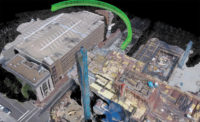Pushing the limits of additive-manufacturing processes, 3D-printing startup Branch Technology recently completed installation of a bandshell in Nashville, Tenn., that it says is the largest 3D-printed structure in the world.
At 20 ft tall and 42 ft across, the bandshell is composed entirely of segments printed out by Branch’s robots in the firm’s distinctive freeform, open-cell structural style. The bandshell has no steel elements other than base plate connections.
Commissioned by developer Cambridge Inc. for its ONEC1TY Nashville property, the bandshell weighs half as much as a comparable steel structure. It’s made of a proprietary resin developed by Branch and was printed off site in 36 segments. In compliance with building codes, the self-supporting structure can bear 1 in. of ice buildup and 12 in. of snow, and it can withstand 90-mph winds.
“The material is quite delicate and light,” explains Rob Otani, principal and CTO at Thornton Tomassetti, which served as structural engineer for the project. “It’s not structural steel, it’s not concrete. It’s got some limitations in terms of embodied strength, but because it’s 3D-printed, we can adjust the thicknesses and change the printing patterns to modify the strength and stiffness of the material. In that way, it’s a bit more responsive than traditional building materials.”
Because the robot can print almost any shape, it was much easier for the team to quickly iterate new designs and test them. For Otani, taking this project to 3D printing from earlier designs that called for a steel structure offered fresh options. “The main takeaway from this is there are some projects that can be realized from this technology that just can’t be done with conventional materials,” he says.






Post a comment to this article
Report Abusive Comment